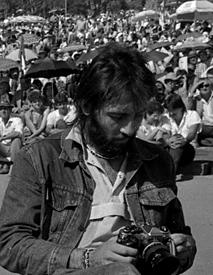Kevin Carter facts for kids
Quick facts for kids
Kevin Carter
|
|
|---|---|
 |
|
| Born | 13 September 1960 |
| Died | 27 July 1994 (aged 33) Parkmore, Johannesburg, South Africa
|
| Occupation | Photojournalist |
|
Notable work
|
The Vulture and the Little Girl |
Kevin Carter (born 13 September 1960 – died 27 July 1994) was a brave photojournalist from South Africa. A photojournalist is someone who tells stories using pictures for newspapers and magazines. He was part of a group of photographers called the Bang-Bang Club.
In 1994, Kevin won a very important award called the Pulitzer Prize. He won it for a powerful picture he took during a terrible famine in Sudan. A famine is when there is not enough food for many people. Kevin Carter passed away that same year when he was 33 years old. His life and work are shared in a book called The Bang-Bang Club.
Contents
Early Life in South Africa
Kevin Carter was born in Johannesburg, South Africa. He grew up in a neighborhood where only white people were allowed to live. Sometimes, he saw police arresting black people who were living there without permission.
After high school, Kevin joined the army. He later decided to become a news photographer. He wanted to show the world what was happening around him.
Starting His Photography Career
Kevin began his career taking pictures of sports events in 1983. In 1984, he started working for a newspaper called The Johannesburg Star. His job was to show the harsh reality of apartheid. Apartheid was a system in South Africa that kept people of different races separate and treated black people unfairly.
Journey to Sudan
In March 1993, Kevin Carter got a chance to travel to Sudan with his friend, João Silva. They went there to photograph a terrible famine. The United Nations (UN) wanted to show the world how bad the famine was so that more help could be sent.
Kevin and João were not involved in politics. They just wanted to take pictures to show what was happening. They flew to a place called Ayod with the UN to photograph people suffering from hunger.
The Pulitzer Prize Photo
While in Ayod, Kevin Carter took a very famous and sad picture. It showed a child who had fallen to the ground from hunger. A large bird called a vulture was nearby. Kevin was very upset by what he saw. He chased the vulture away from the child.
This photograph was printed in The New York Times newspaper on 26 March 1993. People all over the world saw it. Many people called the newspaper to ask what happened to the child. The newspaper said that the child got up and continued walking after Kevin chased the vulture away. However, it was not known if the child reached the UN food center.
In April 1994, Kevin Carter won the Pulitzer Prize for Feature Photography for this powerful photograph. Years later, in 2011, it was learned that the child in the photo was actually a boy named Kong Nyong. He had been helped by the UN food station. Sadly, Kong Nyong passed away around 2007 from a fever.
Other Important Work
In March 1994, Kevin Carter took another important photograph. It showed three members of a group called the Afrikaner Weerstandsbeweging being shot. This happened during a conflict just before the South African election. This picture was shown on the front page of many newspapers around the world.
His Passing
Kevin Carter passed away on 27 July 1994, when he was 33 years old. This was just four months after he won the Pulitzer Prize.
See also
 In Spanish: Kevin Carter para niños
In Spanish: Kevin Carter para niños

